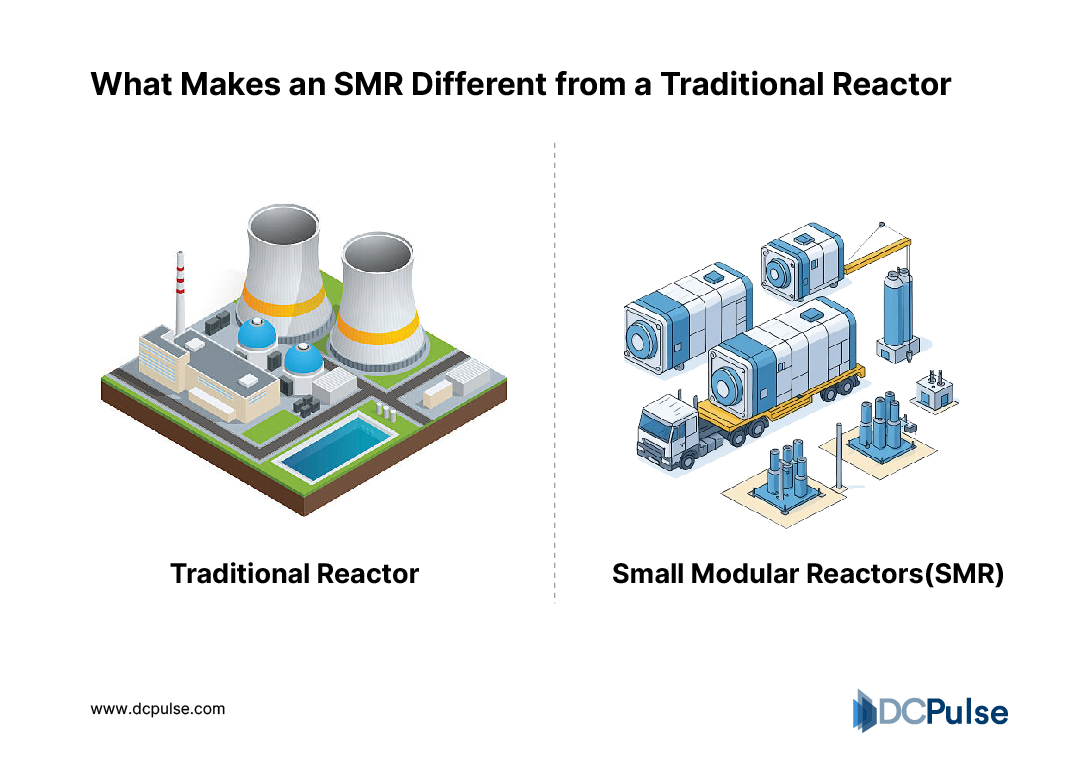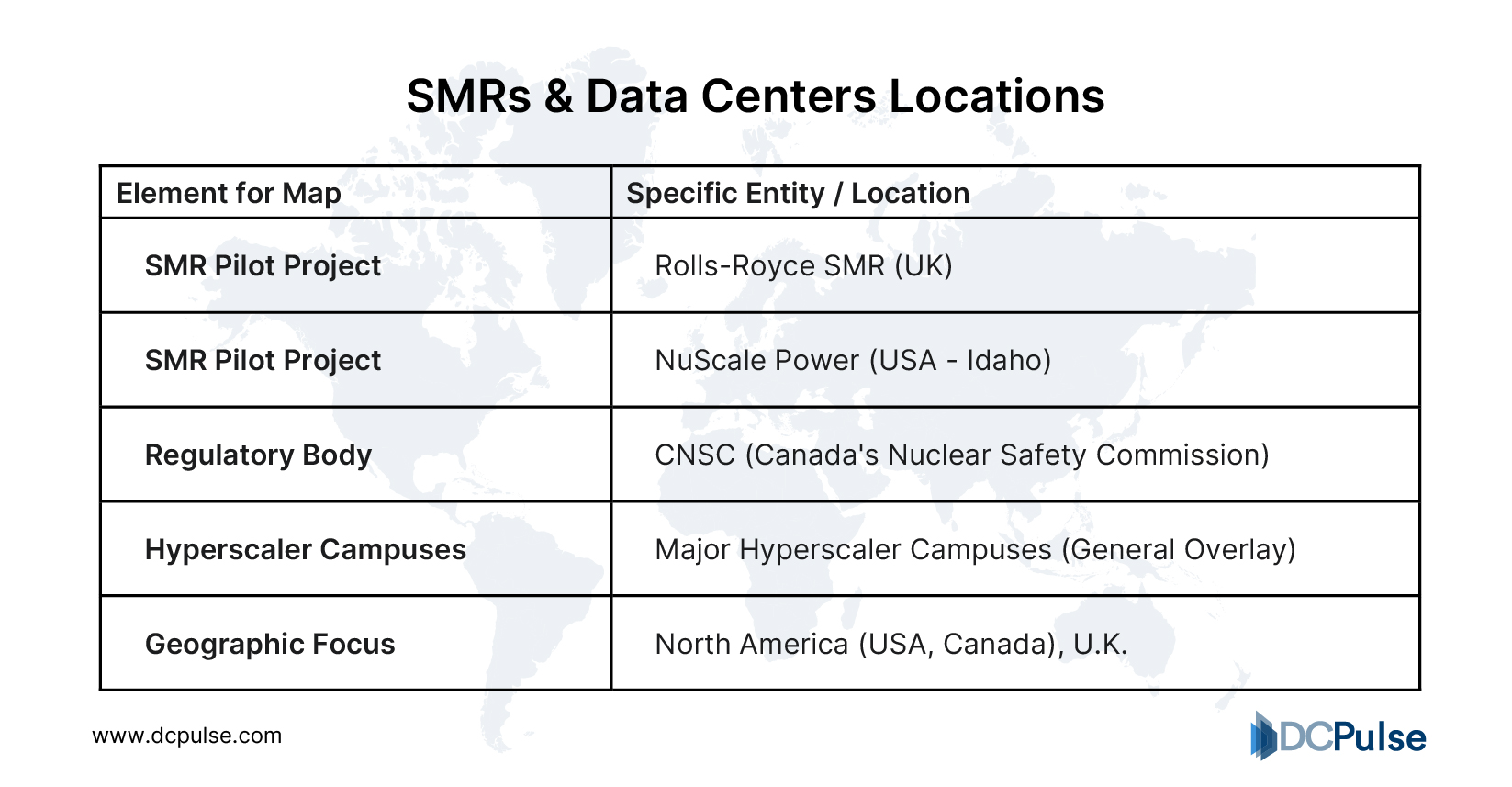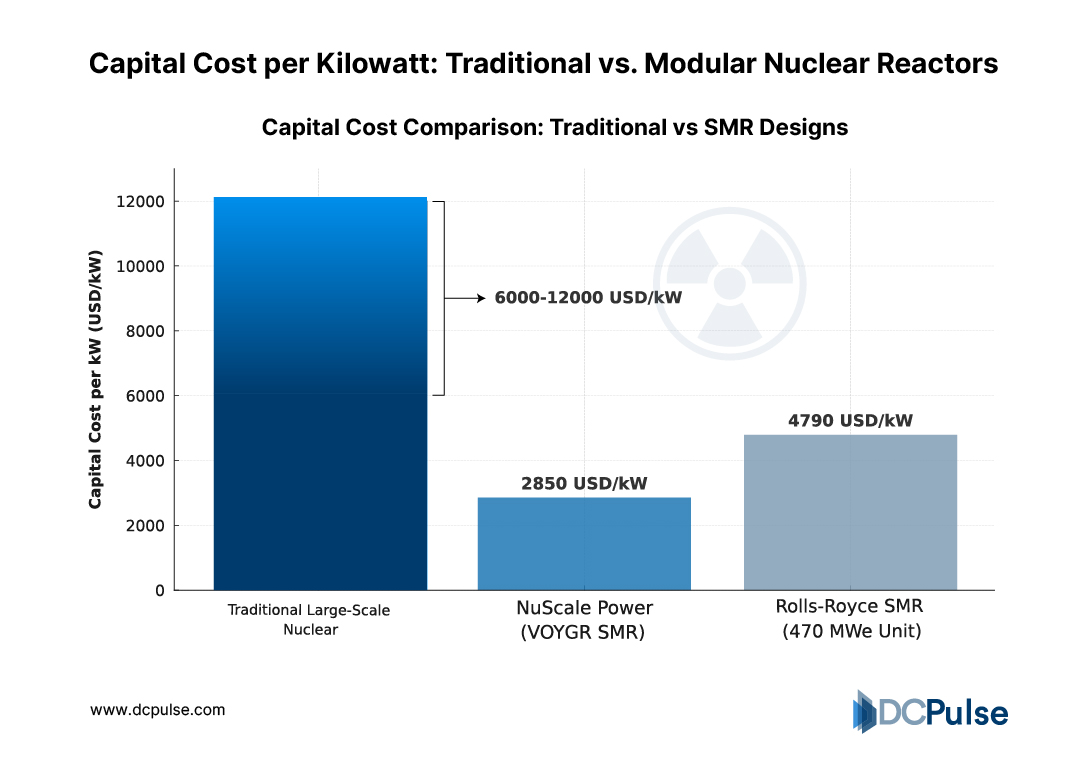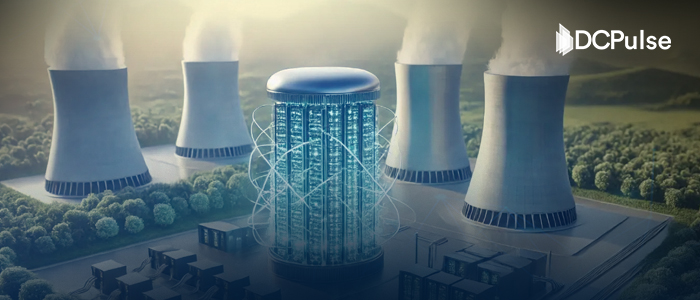The demand for electricity from AI data centers is rising faster than anyone expected. Every new model needs more power than the one before it, putting pressure on already stretched grids. Companies are searching for reliable, low-carbon energy sources that can scale fast, and nuclear power is back in the conversation.
The question is whether small modular reactors (SMRs) can deliver the energy that the next wave of AI will need?
Why Are Data Centers Struggling to Keep Up with AI?
The AI boom has unleashed an energy demand unlike anything the data centre industry has seen before. Each new generation of AI models needs more computational muscle, and that power translates directly into electricity. What began as a manageable increase in server loads is now becoming a grid-level problem.
Studies suggest the global data centre electricity consumption could double between 2022 and 2026, rising from about 460 terawatt-hours (TWh) to over 1,000 TWh, roughly the combined annual use of Japan and Germany.
AI is a major driver of that growth. Every LLM training run can consume millions of kilowatt-hours, and inference, the process of running those models in production, adds a continuous power draw that never really switches off.
Projected Global Data Center Electricity Demand (2022–2026)
In the United States, data centres already account for about 4.4% of total electricity consumption, and according to projections from the U.S. Department of Energy, that figure could climb to as high as 12% by 2028.
The rise of AI clusters, vast server farms designed to train and serve generative models, is accelerating that shift. Nvidia, Microsoft, and Google are all expanding high-density AI campuses that each demand hundreds of megawatts of continuous power, equivalent to small cities.
.jpg)
In places like Phoenix, Arizona, or Ashburn, Virginia, these clusters are starting to test the limits of regional grids. A recent study from Stanford University’s “And the West” project noted that Phoenix-area data centres already draw about 1.5 gigawatts, and that number is climbing fast. Local utilities are warning that grid capacity and water use for cooling are both becoming critical constraints.
Global Grid Tension and SMR Solutions (October 2025)
Renewables, while growing, cannot always keep up. Solar and wind fluctuate with weather and time of day, making them unreliable for the 24/7 uptime AI requires. Batteries can help balance the load for hours, not days. As a result, data centre operators are facing a growing reliability gap, one that’s forcing them to rethink how and where they source power from.
.jpg)
Energy Sourcing for AI Infrastructure: Renewables, Grid, and SMR Integration
That’s why the question of nuclear, particularly small modular reactors (SMRs), is re-emerging. Unlike traditional nuclear plants, SMRs can be built near industrial sites or data campuses, generating between 50 and 300 megawatts of continuous, carbon-free electricity. They promise the kind of steady baseload that AI infrastructure now demands, but whether they can truly fill that gap is another question entirely.

How Could Small Modular Reactors Solve the Problem?
If today’s data centers are straining under AI’s power demand, small modular reactors could, at least in theory, steady the grid beneath them. Unlike traditional nuclear plants that take a decade or more to build and generate over a gigawatt of power, SMRs are designed for flexibility. Each unit typically produces 50 to 300 megawatts, a scale that matches the energy appetite of a large AI campus.
What Makes an SMR Different from a Traditional Reactor
Their modularity makes them particularly attractive. SMRs can be factory-built and transported in sections, reducing construction time and cost. According to the U.S. Department of Energy, this approach could shorten deployment to three to five years, compared to the decade-long timelines of conventional reactors.
Another key feature is load-following capability, the ability to ramp power output up or down as demand fluctuates. Traditional nuclear reactors operate best at a constant rate, but SMRs can adjust to the uneven rhythm of AI workloads. Rolls-Royce SMR and NuScale Power have both demonstrated designs capable of flexible output, maintaining efficiency even at part load.

SMR vs. Traditional Reactor: Load-Following and Efficiency Dynamics
SMRs also bypass many of the transmission constraints that limit renewables. They can be located close to, or even within, industrial campuses, delivering baseload energy without drawing heavily from regional grids. That proximity is one reason the U.K. government and Canada’s CNSC are exploring data-center-adjacent SMR pilots.

Emerging SMR Pilot Regions: SMRs and Data Centers
For hyperscalers promising net-zero operations, the technology’s carbon profile is another draw. A 2023 analysis by the International Atomic Energy Agency found that the full-cycle emissions of advanced nuclear systems are comparable to wind and lower than solar PV, once land use and materials are factored in.

Lifecycle Carbon Emissions Comparison
In essence, SMRs could give data centers something the grid increasingly struggles to provide, a stable, scalable, and clean power source that grows with the AI economy instead of straining against it. Whether that promise holds up financially, though, is the next big question.

Are Small Reactors Worth the Price?
Building a nuclear reactor to power an AI campus sounds expensive, and it is. The real question is whether these compact reactors can make financial sense compared with wind farms, solar parks, or the long-term grid contracts tech companies already rely on.
Right now, the numbers tell a mixed story. Most small modular reactor (SMR) designs sit in a projected range of USD 60 to USD 120 per MWh, depending on who builds them and where. NuScale Power initially targeted an LCOE of ~USD 55/MWh. That’s higher than solar or onshore wind, which can deliver electricity for USD 30 to USD 50/MWh.
However, it comes with something renewables still struggle to offer, a continuous, round-the-clock supply. For data centers that need to run nonstop, steady power is what really counts.
Levelized Cost of Energy (LCOE) Comparison: SMRs vs. Renewables and Gas
The price gap could also narrow fast. Traditional nuclear plants are built almost entirely on-site, with massive labour costs and decade-long timelines. SMRs flip that model by being factory-built, shipped in pieces, and assembled in far less time. NuScale estimates capital costs at around USD 2,850/kW for a “nth-of-a-kind” 924 MW plant. Meanwhile, Rolls-Royce SMR’s target of GBP 1.8 billion for a 470 MWe unit shows the modular strategy’s promise.
_Comparison_SMRs_vs._Renewables_and_Gas.jpg)
Capital Cost per Kilowatt: Traditional vs. Modular Nuclear Reactors
Financing will likely decide who gets there first. Governments are sourcing early capital via public-private programmes such as Great British Nuclear in the UK (with Rolls-Royce) and the US DOE’s advanced-reactor funding stream (with NuScale and others). A future scenario, data-centre operators themselves signing long-term nuclear power contracts, the same kind of power-purchase agreements (PPAs) that helped make wind and solar mainstream.
If those models hold, analysts expect costs to fall steadily through the decade. By the early 2030s, a mature SMR design could reach parity with gas-fired plants, especially in regions where the grid is already maxed out or where renewable storage is too costly.
In short, SMRs won’t be the cheapest option on paper today, but for hyperscalers chasing clean, uninterrupted energy, they might soon be the smartest investment.

Are Small Reactors Finally Moving from Plans to Reality?
The promise of SMRs has long hovered in the realm of future-tech, held back by decades-old regulatory mazes and cautious investors. But over the past 18 months, the first real signs of progress are mounting, suggesting SMRs might be moving from blueprint to power plant.
In the U.S., NuScale Power became the first company to receive design-certification approval from the U.S. Nuclear Regulatory Commission (NRC) for its 50 MWe module back in January 2023. More recently, in May 2025, NuScale announced approval for an uprated 77 MWe design. These milestones shift SMRs from theoretical to deployable, exactly the kind of signal that data-centre operators and hyperscalers need.
Meanwhile, in the U.K., Rolls-Royce SMR has successfully completed Step 2 of the Generic Design Assessment (GDA) process conducted by the Office for Nuclear Regulation (ONR) and moved into Step 3, making it the most advanced SMR design under review in Europe.
Global SMR Regulatory Progress Map (2025)
These regulatory wins are more than just check boxes. They carry implicit signals, that funding is moving, that licensing risk is lowering, and that real-world deployments may follow.
.jpg)
For example, NuScale’s deal with ENTRA1 Energy, a USD 25 billion infrastructure agreement announced in October 2025, specifically cites SMRs powering data-centre growth.
Still, hurdles remain. Construction licences, grid integration, financing, and public acceptance issues continue to slow the pace. SMRs are entering the final stretch of long-gestating regulatory paths, and just one delay could shift the timeline for AI-campus deployment out of reach.
However, the momentum is tangible. Multinational agreements, early site selections (in Canada, the UK, and the U.S.), and government-backed programmes are all flashing green. Whether SMRs can scale in time to power the next wave of AI remains uncertain, but they’re no longer just theoretical. The technology is moving, and the question is now how fast.
Can SMRs Truly Meet AI’s Demand?
Technically, the answer is yes. Small modular reactors can deliver the constant, high-density power that large AI campuses need, and their compact footprint makes colocating generation with compute far more practical than traditional nuclear plants. Their load-following ability means they can sync with the fluctuating rhythm of AI workloads, something renewables alone still struggle to do.
Economically, the equation is tightening. SMRs remain costly today, but their modular build promises falling prices once factories scale. As governments, utilities, and hyperscalers experiment with joint-financing models, the path to cost parity with gas-fired plants looks increasingly realistic by the early 2030s.
Politically, progress is slower. Licensing pipelines, public perception, and long safety reviews keep the pace cautious. Yet every new approval, from the U.S. NRC’s certification of NuScale’s 77 MWe design to the U.K.’s GDA advances for Rolls-Royce SMR, nudges that inertia forward.
Environmentally, the case is strongest of all. Lifecycle emissions from advanced reactors rival wind and undercut solar, offering the rare combination of reliability and deep decarbonization.
Small modular reactors may not ignite the next AI boom, but without them, the boom may well fizzle in the dark.


.jpg)
.jpg)
